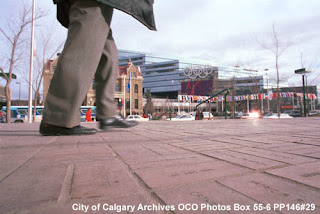“When chickens start
scratching, wrote the Albertan in
August 1913, “there’s no telling what they will scratch up.”[1]
The chicken is in question
belonged to Wilfred J. Watson, and they scratched up a missing by-law, an
illegal street closure, and a conflict that made headlines for days.
This story began in 1907 when
the city extended its southern city limit beyond 17th Avenue. If initial plans
had been followed, Centre Street would have ended at the banks of the Elbow
River opposite today’s Lindsay Park.
Instead, the street ends half
a block further north, forming a T-intersection with 18th Avenue. Although
never actually constructed, the missing road did exist legally. It is now the
parking lot at St. Mary’s high school.
In 1908, A.L. Nunns built a
home on 18th Avenue and asked the city to lease him the vacant right-of-way so
he could extend his yard along the river.
There were no plans to build
a bridge at that point, so the street was not needed. The city leased the land
to Nunns for one dollar per year for his “quiet and peaceful enjoyment.”[2]
He planted it with trees, and
soon the Centre Street “stub” was forgotten.
In 1912, Nunns to
England, and he rented his property to Wilfred J. Watson. Watson raised chickens,
and this quickly offended the neighbours.
“He neglected the training of
the chickens,” the Albertan wrote,
“and did not teach them to stay at home.”
Exasperated at seeing their
gardens rated by errant chickens, neighbors sought revenge. They seized on a
technicality.
When Nunns first leased the
property, it was discovered, council forgot to pass the necessary street
closure by-law.
Neighbors who didn't like
chickens suddenly transformed into concerned citizens demanding the reopening
of Centre Street. They argued that a bridge would soon be needed for the new
Canadian Northern Railway yards being built across the river.
There motive was suspect. Asked
when such a bridge would be required, a CNoR official replied, not “in 1,000
years.”[3]
Nunns, from his home in
London, offered his own theory. He believed that a corral owner in the area,
J.J. McHugh, was behind the move—so he could water his horses.
“This, he used to do before
the street was closed,” Nunns wrote the mayor, “and the dirt and noise not to
mention the rough language of the teamsters were anything but pleasant.”
City Council judged the 1908
lease invalid, and Watson’s chickens lost the right to scratch on the Centre
Street “stub.” It continued to exist on paper, but in reality it remained a
little park with trees. Finally, in 1934, council passed the by-law to close
the road that never really was.








